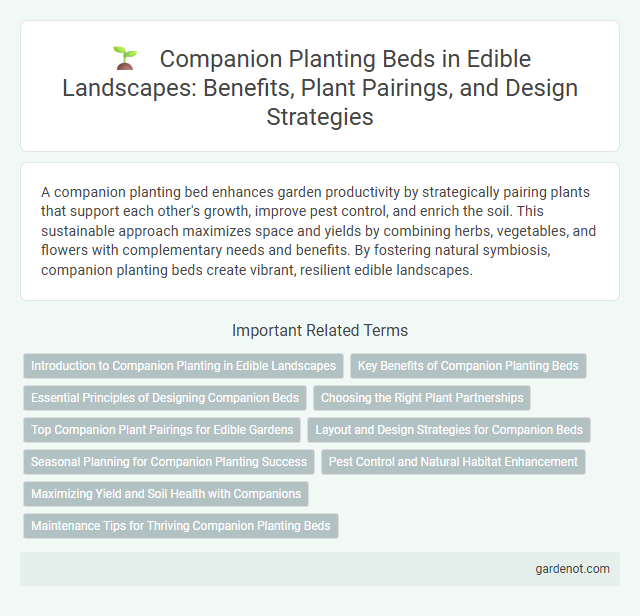A companion planting bed enhances garden productivity by strategically pairing plants that support each other's growth, improve pest control, and enrich the soil. This sustainable approach maximizes space and yields by combining herbs, vegetables, and flowers with complementary needs and benefits. By fostering natural symbiosis, companion planting beds create vibrant, resilient edible landscapes.
Introduction to Companion Planting in Edible Landscapes
Companion planting in edible landscapes involves strategically placing compatible plants together to enhance growth, deter pests, and improve soil health. By pairing herbs, vegetables, and flowers that support each other's needs, gardeners can increase biodiversity and reduce the reliance on chemical fertilizers and pesticides. This sustainable technique maximizes space, yields, and the overall resilience of edible garden beds.
Key Benefits of Companion Planting Beds
Companion planting beds enhance soil health by naturally improving nutrient availability and reducing the need for chemical fertilizers. They promote pest control through biodiversity, attracting beneficial insects that suppress harmful pests without pesticides. This practice increases crop yield and resilience by optimizing plant interactions and encouraging healthy growth in edible landscapes.
Essential Principles of Designing Companion Beds
Designing companion planting beds relies on principles such as selecting plants with complementary growth habits, nutrient needs, and pest deterrent properties. Strategic spacing enhances airflow and reduces disease risk, while integrating diverse species promotes soil health and maximizes space utilization. Balancing shade and sun requirements ensures optimal photosynthesis and productivity in edible landscapes.
Choosing the Right Plant Partnerships
Selecting the right plant partnerships in a companion planting bed enhances growth, pest control, and soil health by combining compatible species like basil with tomatoes, or carrots with onions. Understanding plant families, growth habits, and nutrient needs helps optimize space and maximize yield in edible landscapes. Strategic pairings reduce the need for chemical interventions, promoting a sustainable and productive garden ecosystem.
Top Companion Plant Pairings for Edible Gardens
Tomatoes and basil form one of the most effective companion planting pairs, enhancing tomato flavor and repelling pests like whiteflies and aphids. Marigolds planted alongside vegetables such as beans, cucumbers, and peppers deter nematodes and attract beneficial insects, improving garden health. Carrots grown near onions experience reduced pest damage, while legumes like peas enrich soil nitrogen, benefiting adjacent plants like lettuce and spinach.
Layout and Design Strategies for Companion Beds
Companion planting beds benefit from strategic layout and design that maximizes plant compatibility and maximizes space efficiency. Grouping plants with complementary growth habits, nutrient needs, and pest-repelling properties enhances ecological balance and yield within the bed. Incorporating vertical supports and successional planting ensures continuous productivity and effective use of light and soil resources in edible landscape companion beds.
Seasonal Planning for Companion Planting Success
Seasonal planning for companion planting success involves selecting plant pairs that thrive together during specific growth cycles, enhancing pest control and nutrient sharing. Incorporating cool-season crops like spinach with early peas supports soil health while maximizing space before warm-season vegetables take over. Timing planting to match seasonal conditions ensures optimal companion benefits, improving yield and reducing the need for chemical interventions in edible landscapes.
Pest Control and Natural Habitat Enhancement
Companion planting beds improve pest control by attracting beneficial insects such as ladybugs and predatory wasps, which naturally reduce harmful pest populations. Incorporating diverse plant species like marigolds, basil, and nasturtiums creates a balanced ecosystem that deters pests through natural repellence and habitat support. Enhancing natural habitats with companion plants also promotes pollinator activity, increasing overall garden health and productivity.
Maximizing Yield and Soil Health with Companions
Companion planting beds optimize space by combining mutually beneficial plants that enhance nutrient uptake and pest resistance, resulting in increased overall yield. Integrating nitrogen-fixing legumes with heavy feeders like tomatoes enriches soil fertility naturally, reducing the need for chemical fertilizers. Diverse root structures improve soil aeration and microbial activity, boosting long-term soil health and sustainability in edible landscapes.
Maintenance Tips for Thriving Companion Planting Beds
Regularly monitor companion planting beds for pest activity and remove weeds to reduce competition for nutrients and water. Apply organic mulch to retain soil moisture, regulate temperature, and suppress weed growth, promoting healthy root development. Rotate plant families annually and prune overcrowded plants to enhance air circulation and prevent disease, ensuring a thriving edible landscape.
Companion planting bed Infographic

 gardenot.com
gardenot.com